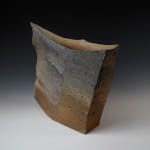Koyama Yasuhisa 神山易久 b. 1936
H36.8 x W35.5 x D10.1 cm
Further images
-
(View a larger image of thumbnail 1
)

-
(View a larger image of thumbnail 2
)

-
(View a larger image of thumbnail 3
)

-
(View a larger image of thumbnail 4
)

-
(View a larger image of thumbnail 5
)

-
(View a larger image of thumbnail 6
)

-
(View a larger image of thumbnail 7
)

-
(View a larger image of thumbnail 8
)

-
(View a larger image of thumbnail 9
)

-
(View a larger image of thumbnail 10
)

-
(View a larger image of thumbnail 11
)

-
(View a larger image of thumbnail 12
)

-
(View a larger image of thumbnail 13
)

-
(View a larger image of thumbnail 14
)

-
(View a larger image of thumbnail 15
)

-
(View a larger image of thumbnail 16
)

KOYAMA Yasuhisa’s sweeping shigaraki vessel captures the energy of a strong gale and gusts of wind that erode the earth over time. Stone is no match for the centuries of wind that wear down its surface, revealing the fossils and age that the stone body has lived. The faceted large flower jar provides sharp angles that offer the idea of speed, conjuring many movements at once. First, the wind. Second, the decisive moment of a brushstroke meeting a surface. The weightiness of the stone, in tandem with the invoked agility of wind and movement, creates an affectual tension in this powerful flower jar. This is the idea that Koyama has captured in this dynamic vessel full of “Ki” 気 (a natural energy). It is a welcome challenge for the talented Ikebana artist.
In addition to its forceful form, the natural shigaraki surface is sensitive and subtle. The cool and warm hues graduate from one to another, creating a symphony of alternating tones. Not only that, but the artist has utilized a faceted surface in order to capture the subdued side of Shigaraki in different lights. If seen in natural light, the piece takes on a different look at various times of the day. It demands slow-looking from the beholder.
Koyama was born in 1936, and in his lifetime, he has been a forerunner of reviving the art of shigaraki, bringing it into the stage of contemporary craft. His pioneering spirit comes through in all stages of his craft. He was the first potter to construct a modern anagama (tunnel “cave” kiln) for his ash-glazed and unglazed surfaces, reviving medieval ceramic techniques imported from China to Japan during the Tang dynasty via maritime trade. Koyama has a great sense for surface texture and its relationship to form, as demonstrated in this vase; His talent has earned him widespread praise and an illustrious career spanning over 3 decades of solo exhibitions. His works are held in the permanent exhibitions of the Metropolitan Museum of Art, the Brooklyn Museum of Art, the Cleveland Museum of Art, the Stedelijk Museum, and more.















